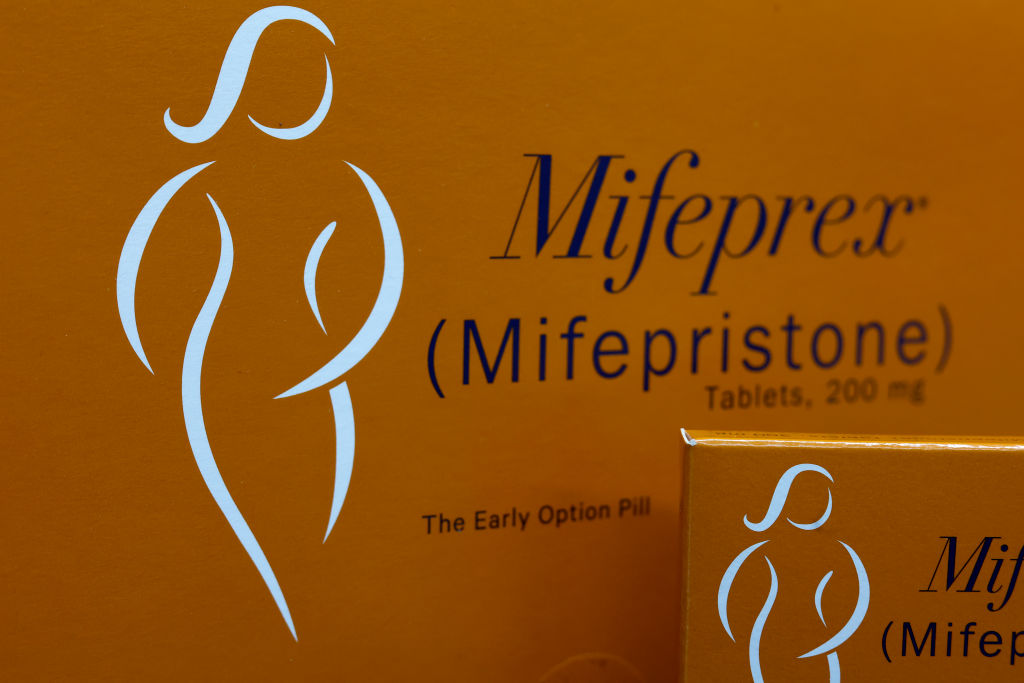“Many ask me ‘How can I support someone in Texas or Alabama needing an abortion?’” said Francine Coeytaux, public health expert. “My answer: Donate to the Abortion Pill Sustainability Fund.”

Six states have shield laws, which allow healthcare clinicians licensed in those states to provide telemedicine abortion care to patients living in states with abortion bans (“ban states”).
As a result, shield-state clinicians are providing telehealth consultations and FDA-approved abortion pills by mail to around 12,000 patients in ban states each month—over 13 percent of the approximately 88,000 abortions provided within the formal healthcare system across the country each month.
While most of these clinicians charge only $150 for this service, approximately one-third of patients need financial assistance. But traditional abortion funds won’t cover telemedicine abortion for people living in ban states—they will only support patients who are willing and able to travel for abortion care in states with legal abortion, which is very costly and time consuming. So, many people are forced to find abortion pills outside of the formal medical system.
To address this gap in support, Healthcare Across Borders (HCAB) has launched a new Abortion Pill Sustainability Fund to support shield-state clinicians serving patients in states banning abortion.
“We are supporting quick, very affordable abortion care,” said HCAB founder and executive director Jodi Jacobson. “Traditional abortion funds will not support the mailing of pills from shield-law states to people living in ban states. With traditional abortion funds, the patient has to wait till the money is available, which potentially means waiting weeks into a pregnancy.
“Here someone gets care when they find out they’re pregnant, and they get it immediately. Rather than spending gobs of money for travel and later-term abortions because it takes so long to get everything together, telemedicine abortion is more cost effective and it doesn’t delay people’s abortions. And it reduces the number of later abortions.”
HCAB has already raised over $350,000 and started disbursing funds to clinicians based on the number of clients seen and served. In December 2023, they supported clinicians with grants totaling $80,000, according to Jacobson.
With traditional abortion funds, the patient has to wait till the money is available, which potentially means waiting weeks into a pregnancy. Here someone gets care when they find out they’re pregnant, and they get it immediately.
Jodi Jacobson, founder of HCAB
Telemedicine abortion is much more cost effective than in-clinic medication abortion. Whereas telemedicine abortion from shield-state providers costs between $150 and $250, in-clinic medication abortion care typically costs between $500 to $700—three to four times as much as telemedicine abortion. Adding travel can increase the cost to $1,300 to $1,400.
In other words, the Abortion Pill Sustainability Fund can serve nine to 10 people with telemedicine abortion for the same cost a traditional fund spends to serve one person.
“The beauty of it is that telemedicine abortion pills are far cheaper and easier than traveling to a clinic to get abortion pills,” said Jacobson. “You can get on the phone with a doctor, and get abortion pills by mail within a few days.”
According to the Guttmacher Institute, the number of people who crossed state lines to obtain abortion care more than doubled in the first six months of 2023, from 40,600 in half of 2020 to 92,100 in the first half of 2023. Many of these people traveled to obtain abortion pills from a clinic.
In addition to the financial costs of traveling out of state for abortion care, the logistical and emotional burdens are high as well. People have to arrange for travel and childcare, find the funds to cover it, take time off from work, often cross through a gauntlet of anti-abortion protestors and wait for care while experiencing the symptoms of early pregnancy, including nausea. On the other hand, telemedicine abortion is private, convenient and quick.
“Several of these clinicians have told me stories of people literally bursting into tears on the phone when they realize they’re going to get care without having to stress about it anymore,” said Jacobson. “That’s what it’s all about: people getting the care they need without barriers. Our goal is to make sure clinicians’ work is sustainable and that we can increase the number of clinicians out there doing this.”
These clinicians have told me stories of people literally bursting into tears on the phone when they realize they’re going to get care without having to stress about it anymore. That’s what it’s all about: people getting the care they need without barriers.
Jodi Jacobson
This new fund is also groundbreaking because, unlike traditional abortion funds, they support clinicians directly rather than requiring each patient to call and ask them for the money before they receive care, which can cause delays and push people further into pregnancy.
“This is a sort of reverse abortion fund of the kind that we’re used to where individuals have to go out and find the money in order to get care,” explained Jacobson. “This is the doctor saying I’m giving you care, no matter what, and I will deal with reimbursement later. It doesn’t put the onus on people to get funds for the care they need when they need it.”
HCAB’s Abortion Pill Sustainability Fund works with over a dozen clinicians at the three organizations currently providing these services: Aid Access and Cambridge Reproductive Healthcare Associates, which serve all ban states, and Abuzz, serving about half of ban states. Abortion services are provided to people located in states banning abortion from the six states with telemedicine provider shield laws: Massachusetts, Washington, Colorado, Vermont, New York and California. When distributing grants, HCAB does not ask clinicians to provide detailed information about their patients, but keeps reporting very simple.
“The clinicians tell me the numbers are increasing exponentially. Part of the reason that the Abortion Pill Sustainability Fund is so critical is that these clinicians have been providing care on a sliding scale out of their own pockets. So someone calls them and says, I don’t have $150, and they may say, What can you pay? And that person may say $5, or they may say I don’t have any money. They may say I can pay $25. That doesn’t mean it doesn’t cost the baseline $150 for that clinician to provide the care. It still does. So the clinician is out of pocket.”
HCAB reimburses clinicians who provide abortion pills to clients in Alabama, Arkansas, Georgia, Idaho, Indiana, Kentucky, Louisiana, Mississippi, Missouri, North Dakota, Oklahoma, South Carolina, South Dakota, Tennessee, Texas and West Virginia. This includes all states banning abortion at six weeks or less.
This is the doctor saying: I’m giving you care, no matter what, and I will deal with reimbursement later.
Jodi Jacobson
“This is an innovation we should have pushed long ago because more people would have had access to abortion a long time ago,” said Jacobson. “We didn’t, but now we’re in a place where these bans are forcing a sea change in the field. More people are now getting care when they otherwise couldn’t. They are getting care in the poorest communities in the country, in states like Texas and Louisiana, without having to leave their homes.”
Another organization, the Abortion Coalition for Telemedicine (ACT), provides clinicians with the direct legal and technical support needed to operate an interstate telemedicine practice serving people in ban states.
“Telemedicine is much more sustainable. That’s something we really do have to grapple with as a movement,” said Julie Kay, executive director of ACT.
ACT is already funding providers through a pilot project, but has a broader vision. “How can we do more than just giving out block grants of money to clinicians? How can we make sure that the patient experience is truly one that’s equitable? How can we reach out to the people most in need, and not just the ones who are the most tech savvy?” said Kay.
ACT plans to hire an outreach coordinator to connect with communities not yet aware of these telemedicine abortion services. “A community focus is what the fund model has always been. It’s been state-based and very locally-driven. We don’t want to replace that. We want to show what are the legal risks and how do we minimize them? We’re hoping that by doing the ACT Fund pilot we’ll be able to demonstrate to the regular funds that it’s okay to do this and that more and more will come on board,” said Kay.
About the resistance to supporting shield-state telemedicine abortion providers, Kay said: “Organizations and movements are slow to change. It takes a long time to turn a big ship, and we’ve got some big ships now. And there’s a lot of misinformation out there on mifepristone, even in our own community.”
One telemedicine abortion provider from Aid Access expressed frustration that traditional abortion funds won’t support their work or even list this more affordable option on their websites. “We’re like the unwanted stepchild of the repro field, being shield providers and doing telehealth. It’s just crazy to me how people don’t get what this can do.”
There are some funds that support telemedicine abortion, such as the California-based Women’s Reproductive Rights Assistance Project (WRRAP) and the Abortion Freedom Fund.
In April 2022, WRRAP created the Abortion Pill By Mail Program to fund telemedicine abortion providers at a time when few abortion funds were willing to do so. WRRAP gave funds directly to medical providers so that patients didn’t have to call WRRAP to arrange the funding.
Last year WRRAP supported around 30 providers who, at a cost of $700,000, mailed abortion pills to over 7,000 patients located in states where abortion is legal, but they do not support physicians providing telemedicine abortion care to people living in states with abortion bans.
“We have seen a huge increase in the number of people who are using telemedicine abortion services since we started in April 2022, said WRRAP’s executive director Sylvia Ghazarian. “We get testimonials from people who say they are very happy with “this service. Telemedicine access was tremendous for them because they lived in areas where a clinic was far away and they didn’t have to worry about taking time off from their job or getting child care. And they could do it in the privacy of their own home. There were so many benefits.”
Ghazarian said that many donors and foundations are wary of supporting telemedicine abortion into states with bans for fear that anti-abortion politicians might prosecute them under aiding and abetting laws, as in Texas.
Although, in California, organizations and donors are protected by the state’s shield law, said Julie Kay. “We can’t guarantee that there is no risk with telemedicine abortion into banned and restricted states, but ACT tries to reduce that risk as much as possible, and to inform and support those who are mission-driven to provide access to abortion as a human right.”
Many people living in ban states are now obtaining abortion pills online for as little as $39 or through community networks for free, but many prefer to work with licensed medical clinicians who provide FDA-approved medications. HCAB’s Abortion Pill Sustainability Fund is working to make this option available and affordable for everyone.
We can’t guarantee that there is no risk with telemedicine abortion into banned and restricted states, but ACT tries to reduce that risk as much as possible, and to inform and support those who are mission-driven to provide access to abortion as a human right.
Julie Kay, executive director of Abortion Coalition for Telemedicine
“Your support will help shield-law providers continue to offer this critically needed care and ensure that all people in the United States who need access to a safe abortion with pills can get it, regardless of where they live or their ability to pay,” said Coeytaux.
To donate to funds supporting people living in states banning abortion, go to Healthcare Across Borders Abortion Pill Sustainability Fund and the Abortion Coalition for Telemedicine.
Up next:
U.S. democracy is at a dangerous inflection point—from the demise of abortion rights, to a lack of pay equity and parental leave, to skyrocketing maternal mortality, and attacks on trans health. Left unchecked, these crises will lead to wider gaps in political participation and representation. For 50 years, Ms. has been forging feminist journalism—reporting, rebelling and truth-telling from the front-lines, championing the Equal Rights Amendment, and centering the stories of those most impacted. With all that’s at stake for equality, we are redoubling our commitment for the next 50 years. In turn, we need your help, Support Ms. today with a donation—any amount that is meaningful to you. For as little as $5 each month, you’ll receive the print magazine along with our e-newsletters, action alerts, and invitations to Ms. Studios events and podcasts. We are grateful for your loyalty and ferocity.





